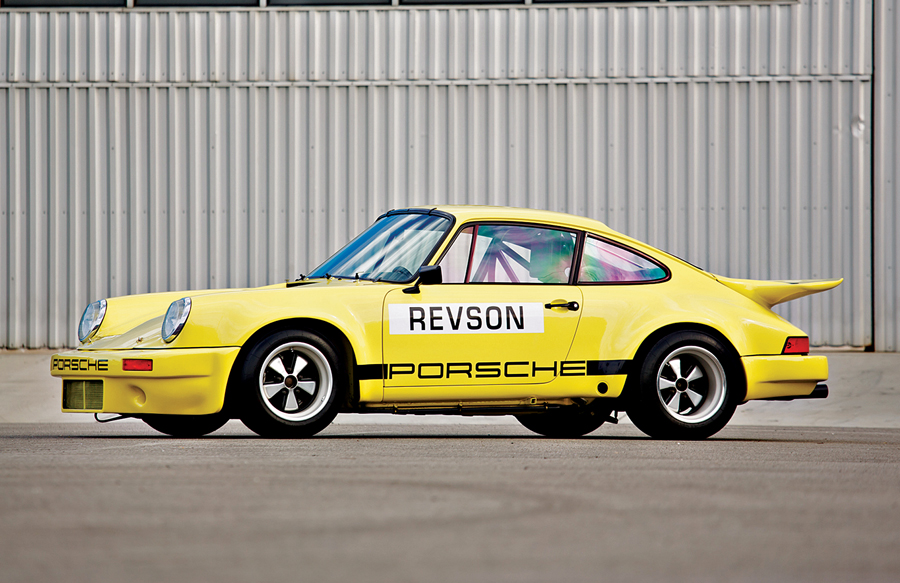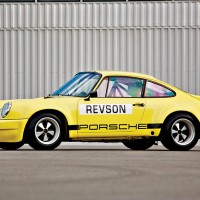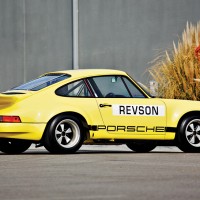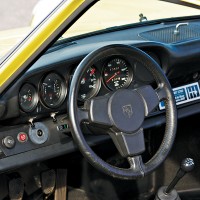SCM Analysis
Detailing
| Vehicle: | 1974 Porsche 911 Carrera 3.0 RSR IROC coupe |
| Years Produced: | 1973–74 |
| Number Produced: | 15 IROC cars, 60 3.0 RSR cars |
| Original List Price: | $25,000 |
| SCM Valuation: | Median to date, $1,100,000; high sale, $2,310,000 (this car) |
| Chassis Number Location: | Bulkhead just aft of gas tank |
| Engine Number Location: | Fan housing support on right side |
| Club Info: | Porsche Club of America |
| Website: | http://www.pca.org |
| Alternatives: | 1972–75 BMW CSL, 1971–73 Ferrari 365 GTB/4C Comp Daytona, 1974 Ford Capri RS |
| Investment Grade: | A |
This car, Lot 36, sold for $2,310,000, including buyer’s premium, at Gooding & Company’s Amelia Island, FL, sale on March 11, 2016.
All air-cooled Porsche values have been on a nosebleed ride for the past few years, but recently a form of rationality has reasserted itself, and prices for “ordinary” cars have flattened or actually declined.
The really good stuff has held up well, though, which brings us to the topic of how to define and recognize the “good stuff.”
A fundamental problem with all of the production-based Porsche racers is in the essence: At some point they all came off the production line and had modifications done to make them racers. It is thus relatively easy for a competent shop to take a street car well after the fact and turn it into something that looks, feels and sounds just like something the factory created in the era. For a racing 911, known history, provenance and originality are hugely important.
Never meant to race
The story begins with the reality that Porsche never intended the 911 to be a racing car.
The basic architecture, with the engine behind the transaxle, was laid out for a comfortable sporting touring car that was easy to access and maintain. Porsche had known from the beginning that a racing application required the mass of the engine to be forward of the transaxle, but that this was impractical for a daily driver.
Like the 356 before it, the 911 proved to be an excellent sporting road car and soon Porsche went to the FIA to get it homologated as a touring sedan. Although the 911 met all of the technical requirements, the Paris-based FIA proved maddeningly intransigent about accepting it as a touring car. In frustration, Porsche decided to homologate the 911 as a Grand Touring car instead, and the die was cast. Grand Touring at the time was a category for far more serious racers than touring sedans were.
A new racing world
The early 1970s were a time of enormous change in the automotive world. In 1968, the United States instituted safety and emissions requirements that the manufacturers were struggling to meet, the world economy (and with it auto sales) was not great, and the glory years of titanic auto racing battles (Ford, Ferrari, Porsche’s 917) that had attracted huge crowds through the late 1960s appeared to be over.
The 908 and 917 programs had been enormously successful for Porsche, but they had been wildly (and probably unsustainably) expensive for a company of Porsche’s size. The 911 successor cars (924 and 928) were on the drawing boards, but they were still years in the future, so Porsche felt it had to keep the 911 as a viable product at least until 1980.
The obvious conclusion was that Porsche had to make a serious racer out of the 911.
Starting with a Ducktail
Since the minimum production for homologation in Grand Touring Group 4 was 500 cars, the first step was to design and build a “homologation special” that would incorporate enough of the essential changes to be the basis of a serious racing car but still sell to the general public as a street ride.
The summer of 1972 saw the beginning of the project, to be called the Carrera RS. The biggest issues to be addressed were weight, fender room for big tires, aerodynamics and horsepower.
Thinner-gauge metal was used for the body panels, thinner glass for the windows, the rear deck was fiberglass and the interior was stripped of anything not absolutely necessary. Installing Bilstein shocks (their first use on a Porsche) saved almost eight pounds.
In all, the Carrera RS was homologated at 210 pounds lighter than a standard 911. The fenders were bulged to accept six-inch front and seven-inch rear wheel widths — and particularly to accept the additional two inches per side that the GT rules allowed for racing. The RS also got the first rear-deck spoiler — a weird-looking but very effective “Ducktail” that improved the drag coefficient and reduced high-speed lift at the back by two-thirds. The engine was a substantial change as well, enlarged to 2.7 liters from the standard 2.5 to allow an easy expansion to 3 liters, which was within the rules.
The Carrera RS was an entirely different car than a 911E.
A formidable racer is born
The next step was to turn the production RS into a proper racing car, logically to be called the RSR. The engine got bigger — to 2.8 liters with big valve heads and twin-plug ignition. The car got the Can-Am 917’s finned brake calipers and cross-drilled discs, a lot more tire, and an oil cooler where the RS’s front license plate used to be.
There were numerous technical changes as well. The Carrera RSR quickly proved to be a formidable competitor, and the end of 1973 filled most racing grids with racing Porsche 911s. 1974 saw continued improvements to the cars, particularly a new aluminum-cased, 3-liter engine and revised rear suspension geometry.
Not only were they the fastest cars on the track, the RSRs proved to be virtually unbreakable. Dominant through the 1975 season — and with turbocharged variants waiting in the wings, the RSR signaled the beginning of Porsche’s incredible period of utter dominance in road racing everywhere in the world. The combination of speed, drivability, availability and extreme dependability cemented Porsche’s reputation as the most successful racing car company in history.
Enter the IROC
When Roger Penske decided to stage the IROC, the Porsche was an obvious choice; fast, recognizable, bomb-proof and available in quantity.
The IROC RSRs that he purchased were a special combination. They were halfway between the quasi-streetable RS and the fire-breathing, full-snort RSR.
As this was a driver’s competition, all 15 cars had to be identical, which ruled out the “demon tweaks” that characterized individual efforts. If you can imagine a very fast Formula Ford with fenders, these were it — as identical as peas in a pod. They had standard fender contours and wheel widths, so they looked like normal Porsches, but they got the new 3-liter engines for power, all tuned to a drivable 316 horsepower.
Not enough race history — but well sold
The result is a very attractive car for a collector, but less so for a racer. These cars are iconic, impressive and relatively easy to drive — but probably not ultimately fast.
There are certainly more valuable Porsche RSRs out there. Although it is beautiful and pure, this car had limited racing success in the United States and none internationally, which can be a major factor in value.
It sold in the upper ranges of RSR values, and I am told it brought a bit above the honest expectations of those involved. I would say it was fairly bought and sold. ♦
(Introductory description courtesy of Gooding & Company.)




